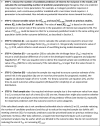Minimum sample size for developing a multivariable prediction model: PART II - binary and time-to-event outcomes
- PMID: 30357870
- PMCID: PMC6519266
- DOI: 10.1002/sim.7992
Minimum sample size for developing a multivariable prediction model: PART II - binary and time-to-event outcomes
Erratum in
-
Correction to: Minimum sample size for developing a multivariable prediction model: Part II-binary and time-to-event outcomes by Riley RD, Snell KI, Ensor J, et al.Stat Med. 2019 Dec 30;38(30):5672. doi: 10.1002/sim.8409. Epub 2019 Oct 29. Stat Med. 2019. PMID: 31793031 Free PMC article. No abstract available.
Abstract
When designing a study to develop a new prediction model with binary or time-to-event outcomes, researchers should ensure their sample size is adequate in terms of the number of participants (n) and outcome events (E) relative to the number of predictor parameters (p) considered for inclusion. We propose that the minimum values of n and E (and subsequently the minimum number of events per predictor parameter, EPP) should be calculated to meet the following three criteria: (i) small optimism in predictor effect estimates as defined by a global shrinkage factor of ≥0.9, (ii) small absolute difference of ≤ 0.05 in the model's apparent and adjusted Nagelkerke's R2 , and (iii) precise estimation of the overall risk in the population. Criteria (i) and (ii) aim to reduce overfitting conditional on a chosen p, and require prespecification of the model's anticipated Cox-Snell R2 , which we show can be obtained from previous studies. The values of n and E that meet all three criteria provides the minimum sample size required for model development. Upon application of our approach, a new diagnostic model for Chagas disease requires an EPP of at least 4.8 and a new prognostic model for recurrent venous thromboembolism requires an EPP of at least 23. This reinforces why rules of thumb (eg, 10 EPP) should be avoided. Researchers might additionally ensure the sample size gives precise estimates of key predictor effects; this is especially important when key categorical predictors have few events in some categories, as this may substantially increase the numbers required.
Keywords: binary and time-to-event outcomes; logistic and Cox regression; multivariable prediction model; pseudo R-squared; sample size; shrinkage.
© 2018 The Authors. Statistics in Medicine Published by John Wiley & Sons Ltd.
Figures



References
-
- Steyerberg EW. Clinical Prediction Models: A Practical Approach to Development, Validation, and Updating. New York, NY: Springer Science+Business Media; 2009.
-
- Wells PS, Anderson DR, Rodger M, et al. Derivation of a simple clinical model to categorize patients probability of pulmonary embolism: increasing the models utility with the SimpliRED D‐dimer. Thromb Haemost. 2000;83(3):416‐420. - PubMed
-
- Wells PS, Anderson DR, Bormanis J, et al. Value of assessment of pretest probability of deep‐vein thrombosis in clinical management. Lancet. 1997;350(9094):1795‐1798. - PubMed
Publication types
MeSH terms
Grants and funding
LinkOut - more resources
Full Text Sources
Other Literature Sources
Medical
